No family get together or holiday party is complete without a yule log. Here’s one…
No family get together or holiday party is complete without a yule log. Here’s one…
The main design assignment for this semester’s Pratt students is a cafe. The students selected their own interior design and had to develop a custom lighting fixture that is integrated with that design. Here area few of this semester’s fixtures.



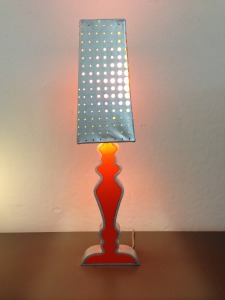
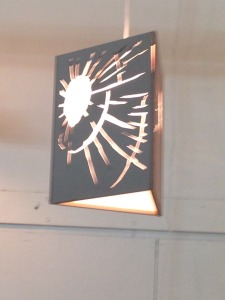
The Lighting Research Center at Rensselaer Polytechnic Institute recently published a short video in which LRC director Mark S. Rea discusses the costs and benefits of lighting. Here it is.
If you set aside the plugs for the LRC, his statements, and those in his book Value Metrics For Better Lighting, are similar to what I’ve said throughout Designing With Light, which is that it’s the quality of the light and lighting design that are of primary significance while the amount of light that is delivered is secondary. Therefore, the true value of the lighting design is found in the design’s success in meeting the multiple requirements of the owner and the occupants of the space, not in the cost of hardware and installation.
Unfortunately, there are several factors that have created resistance to placing value on thoughtful, appropriately designed lighting. The first is that most people simply do not see light (pun intended). For far too many people, if the light is bright enough for them to see what they’re doing it is acceptable and little or no judgment is made regarding the other factors of lighting design, such as color rendering, providing visual interest, overall effect on occupants, etc. I find that if I show clients or students the difference between light that is adequate for vision and light that creates an appropriate atmosphere or environment they can see it and appreciate the difference. It is also a surprise to them that lighting design can make such a difference in a space.
The second factor is that project budgets are set in dollars with no little or no allowance made for the quality of the design. I have often worked on projects where the project budget and the lighting equipment budget have been set, although design work has barely begun. I understand that a client only has so much money to spend and that has to be respected. However, 1) No bean counter in the world can predict what the design team will develop. Budgets are more appropriately set in coordination with the design team after the design team understands the full extent of the client’s needs and desires. Then, if the projected cost exceeds the client’s budget, informed decisions can be made to pull back on certain aspects of the building’s design or to allocate more money to construct the building the client wants. 2) Spending more money up front on efficient lamps and fixtures, and on controls, can more than pay for itself in savings on energy and maintenance.
Another factor is that we value what we can measure. Since the early 1900s the lighting design community has invested a great deal in determining how to measure light and on how much light is required for “visual tasks.” Those two aspects became the criteria for evaluating lighting design, and are still presented as primary in many lighting textbooks. In the 1970s John Flynn and others began to study how light can affect the impressions one forms of a space. Later research examined the relationship between a lighting design and those occupying the lighted space including: the affect on worker productivity, absenteeism, and worker retention; student learning outcomes and test scores; retail sales; a light source’s spectrum and clarity of vision; and light’s affect on sleep cycles and other aspects of health. This research has shown over and over again that intelligent, thoughtful, appropriate lighting design can have a significant effect on the occupants and on the owner’s bottom line, whether that bottom line is to make more money, increase student success, or improve health.
Knowledgeable lighting designers can bring so much more to a building than just illumination, yet illumination and lighting design remain synonymous to most of our colleagues and clients. That is part of the reason only about ten percent of construction projects have a lighting designer on the team. Lighting designers and lighting design professional organizations need to do a much better job of educating design team members and our clients about quality lighting design, what it is, and why it matters.
NPR’s All Things Considered had a brief piece about light and color on Monday. The main thrust of the story was that color is not inherent in an object, but is perceived and interpreted by our brain, but there’s much more to revealing and perceiving the color of objects. Here’s a quick overview.
To begin, all objects have light reflecting properties. Objects that we identify as red reflect most of the red light that falls on them and absorb the other colors. Likewise for objects that appear to be green, blue, etc. Objects that appear to be white reflect the colors of light more or less equally, while objects that appear to be black absorb most of the light that falls on them. Objects only reflect light, they don’t create it, so if we use blue light to illuminate an object that reflects red light we find that no light is reflected and the object appears to be black.
As I explain in Chapter 8, we change the balance of the colors in white light every time we change the light source. Even with a single light technology, such as fluorescent, we change the balance of colors when we change from cool white to warm white. The color content of a light source can be measured (it’s called the spectral power distribution or SPD) and graphed as shown below.

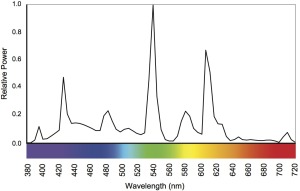
When we change the SPD we change the colors of light that are available for reflection by objects, which means that we also change the balance of light that is reflected and thus the color information that our eyes receive. The result is that changing the light may change the color appearance, or the apparent color, of an object. Many of us have had the experience of buying clothing or paint that was one color in the store and another color at home. Here we see this phenomenon with a color/materials board illuminated by several light sources. How well a light source enables us to perceive colors is called color rendering.
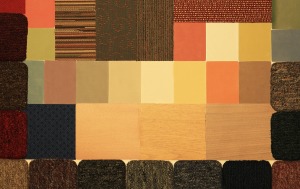
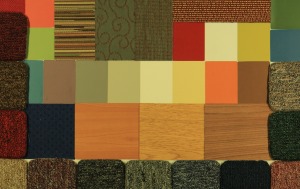
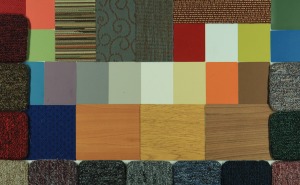
Color and brightness perception are both relative not absolute. A candle in an otherwise dark room may seem too bright to look at directly, while its brightness on a sunny day seems insignificant. In addition to the effect of SPD on our color perception, colors are perceived in relation to one another, especially between foreground and background as shown below.
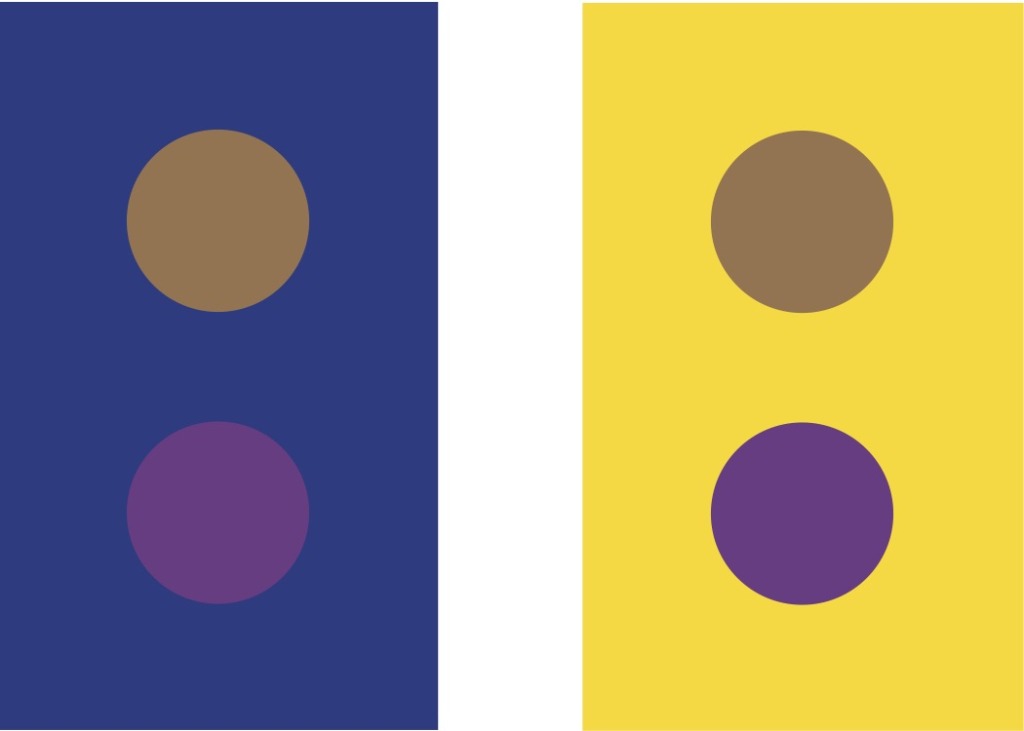
If I can demonstrate shifting our color perception why don’t we experience it in everyday life? Why are my blue jeans blue and my red car red in nearly every lighting situation? The answer is color constancy or chromatic adaptation. It does us no good to spend time and energy struggling to figure out colors. We want to be able to tell if a piece of fruit is ripe regardless of the lighting conditions. Color constancy is our brain’s use of information gathered from the entire visual field to understand the lighting conditions and calibrate our color perception so that color shifts are minimized.
By some estimates less then 10 percent of construction and renovation projects include a professional lighting designer on the design team. Why? Who’s looking after the lighting design? What can the lighting design community do about it?
The reasons projects go forward without a lighting designer range from the owner’s lack of understanding of what a lighting designer does to the architect’s desire to keep fees low. These are usually coupled with the belief that other team members can take care of the lighting just as well as well as a lighting designer. The “others” who may provide some or all of the lighting design include the architect, interior designer, electrical engineer, electrical contractor, and lighting salesperson. These other professions can act as lighting designers because the practice of lighting is so young and is unlicensed.
Why should architects and building owners hire a lighting designer? My first answer is, “You’re hiring experts in every other aspect of building design and construction, so why would you NOT hire an expert in lighting, too? Don’t you want the building to look as good as you imagine it will?” My other answers are:
What can the lighting industry to do promote the use of lighting designers? It seems to me that our professional organizations, especially the IES and IALD, have to take the lead here because individuals can’t have enough impact. Both organizations do a lot of work within the industry, but I don’t see any outreach to the real decision makers. What could they do? Here are a two thoughts:
What do you think? What can we do to promote lighting design?
On September 26, 2014 the U.S. Department of Energy issued a determination that ANSI/ASHRAE/IES Standard 90.1-2013 would achieve greater energy efficiency in buildings subject to the code than the 2010 version. The DOE analyses determined that the energy savings would be:
As a result, all states are now required to certify that they have reviewed the provisions of their commercial building code regarding energy efficiency and, if necessary, updated their codes to meet or exceed the 2013 edition of Standard 90.1. States must submit certification of compliance by September 26, 2016 or explain why they cannot comply.
Why is this happening? The DOE is required by the Energy Conservation and Production Act (42 USC 6833) to review each new edition of ANSI/ASHRAE/IES Standard 90.1, and issue a determination as to whether the updated edition will improve energy efficiency in commercial buildings. If the determination is that the new version will improve energy efficiency, that standard becomes the new nationwide minimum requirement. States aren’t required to adopt Standard 90.1, but whatever standard they develop or adopt must be at least as stringent as Standard 90.1.
Some of the changes in the new standard are:
The DOE website contains additional information, including PDFs of the analyses they conducted.
There are two interesting and related articles on the interwebs today. The first is an article at Climate Central and reprinted in Scientific American that summarizes a study published in Proceedings of the National Academy of Sciences. The study is titled Integrated Life-Cycle Assessment of Electricity Supply Scenarios Confirms Global Environmental Benefit of Low-Carbon Technologies. It looks at the life-cycle environmental and climate costs of a continuing shift to renewable energy through the year 2050. The researchers assumed that by then 39 percent of global electricity production will be generated by renewables and asked themselves what the environmental impact would be.
We all know that sources of renewable energy produce less CO2 during their operation than burning fossil fuels, but that’s not the whole picture. The life-cycle analysis looked at the environmental costs and benefits of renewables and traditional sources of power from their inception (such as mining the ores needed to produce the metal parts) through their entire operational lives. For example, wind turbines require more than 10 times the iron needed for comparable electricity generation powered by oil or coal, and solar panels require up to 40 times more copper. That’s a lot of additional mining, with the associated environmental impact. Are renewables really better for the environment?
The answer turns out to be, “Yes.” How could that be? There are two factors. One is that after a solar panel or a wind turbine is manufactured it doesn’t require additional raw materials. Coal, oil, and gas-fired power plants require a continuous input of new raw materials that are extracted, transported, and then burned. The second is that although renewable energy equipment requires more material to produce, the required amount is a small amount relative to global production. For instance, the copper required for the estimated increase in solar panels over the next 36 years is only 2 years of copper production (or 5 percent) at current rates.
An increase in environmentally friendly energy production is good news because the second article, published in the op-ed section of today’s New York Times, says that historical trends in increased lighting efficiency suggest that we may see an increase, not a decrease, in energy consumption in the years to come. The authors explain that as the production of light became cheaper, from coal gas to whale oil to kerosene to electricity, the demand for these cheaper technologies resulted in an overall increase in energy consumption, a process called rebound. They note that
The I.E.A. and I.P.C.C. estimate that the rebound could be over 50 percent globally. Recent estimates and case studies have suggested that in many energy-intensive sectors of developing economies, energy-saving technologies may backfire, meaning that increased energy consumption associated with lower energy costs because of higher efficiency may in fact result in higher energy consumption than there would have been without those technologies.
That’s not a bad thing. Most people in the world, still struggling to achieve modern living standards, need to consume more energy, not less. Cheap LED and other more efficient energy technologies will be overwhelmingly positive for people and economies all over the world.
But LED and other ultraefficient lighting technologies are unlikely to reduce global energy consumption or reduce carbon emissions. If we are to make a serious dent in carbon emissions, there is no escaping the need to shift to cleaner sources of energy.
A recent article in The Wall Street Journal discussed the possibilities and benefits of lighting systems that shift color to mimic the changes in daylight. It’s a complicated subject so it’s not surprising that some of what’s reported is inaccurate, so let me clarify a few things.
First, our current understanding of how light affects our circadian rhythms is that a light activates a type of cell in the retina called intrinsically photosensitive retinal ganglion cells (ipRGC). These cells, unlike rods and cones, are unrelated to vision. The signal they send to the brain is received by the suprachiasmatic nucleus (SCN), which is the body’s hormone regulator. As the graph below illustrates, the ipRGCs are most sensitive to short wavelength (blue) light and, unlike rods and cones, are unaffected by long wavelength (red) light. (A more detailed explanation can be found in Chapter 16 of Designing With Light, and in this article from the Journal of Circadian Rhythms.)
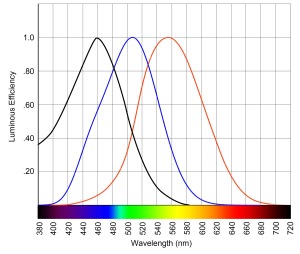
The ipRGCs signal to the SCN, which keeps our circadian rhythms are kept in sync with the day/night cycle, seems to be affected by three factors: color balance; intensity; timing. Cool (bluish) light should be delivered at a relatively high brightness in the morning hours. Delivering cool light in the evening hours can disrupt sleep and other processes controlled by the SCN.
Next, there’s nothing special about LED lighting that makes it uniquely appropriate for this application. Fluorescent, HID, and incandescent light (adjusted with color filters) can all be used to create a system that delivers cool light in the morning and warm light in the evening. In all cases, this involves the use of light sources of several tints (warm, cool, and possibly neutral) that are individually controlled. The WSJ is completely wrong when it says “unlike incandescent or fluorescent lights, LED lights’ materials and electronic components allow for finer adjustments of color, brightness and intensity.” A single LED creates light of a single color. To shift colors a second LED is required. Brightness and intensity are the same thing. With LEDs set to surpass sales of all other light sources within the next several years, research involving sources other than LED is nearly non-existent. Naturally, researchers are using LEDs to test theories and to develop demonstrations and products.
Finally, it would be helpful if the WSJ had defined two terms – color temperature and CRI (Color Rendering Index). Both are explained in Chapter 8. Color rendering and CRI are briefly explained in this post. CRI and color temperature are both addressed in this post.
Today is the People’s Climate March here in New York City. Sponsored by peoplesclimate.org, the march here is joined by events in other major cities around the world, including London, Berlin, Bogota, Istanbul, Paris, Rio, Delhi, Melbourne, Johannesburg, Lagos, and Amsterdam. The marches and other events are intended to put pressure on international leaders who will meet at the United Nations Climate Summit 2014 on Tuesday to create the framework for a global agreement on emissions that (it is hoped) will be agreed upon in Paris late next year.
If that agreement occurs it will certainly be a case of politicians leading from behind. As I’ve noted here and here and here, researchers at organizations as diverse as NASA, NOAA, and IPCC have been telling us that the climate is changing now, that change is accelerating, and that we’ve already reached the tipping point in places like Antarctica’s Western Ice Sheet. And the news just keeps piling up. NOAA has announced that the combined average temperature across global land and ocean surfaces for August 2014 was a record high for the month, at 1.35°F above the 20th century average of 60.1°F, topping the previous record set in 1998. The global land surface temperature was 1.78°F above the 20th century average. Here’s a map of the global temperature variations compared to the base period of 1981-2010.
The August report means that globally, June through August 2014 is the 5th hottest on record. The four periods that were hotter than this year have all occurred since 1998.
Since the founding of the IPCC in 1988 progress has been slow and halting (a history of UN climate actions can be found here). Let’s hope that strong action is agreed to this time.
The Illuminating Engineering Society has released a new Recommended Practice. RP-31-14 Recommended Practice for the Economic Analysis of Lighting is now available as a PDF download or soft back from the IES Online Store. From the IES:
Good lighting should be responsive to the needs of the user. Among those needs are the aesthetic and the visual, as admitted in the oft-quoted “lighting is both a science and an art.” But the user also has economic needs. In fact, it is the economic needs that often drive the decision making process when lighting systems are designed and purchased.
This recommended practice is written from the point of view that “economic analysis” is not the same as “how to beat the budget.” Rather than considering economic analysis as the antithesis of engineering or artistic analysis, is should be thought of as subsuming these other needs. When a competent lighting professional takes care of economic needs, in conjunction with the artistic, engineering, and other needs, it increases the likelihood a project will have success and longevity. Financial considerations ad demonstrated through an accurate lighting financial analysis are important, but other elements such as aesthetics, human visual performance resulting from a lighting system appropriate to a given task, and other considerations involved in lighting for the human and natural environment are of equal importance.